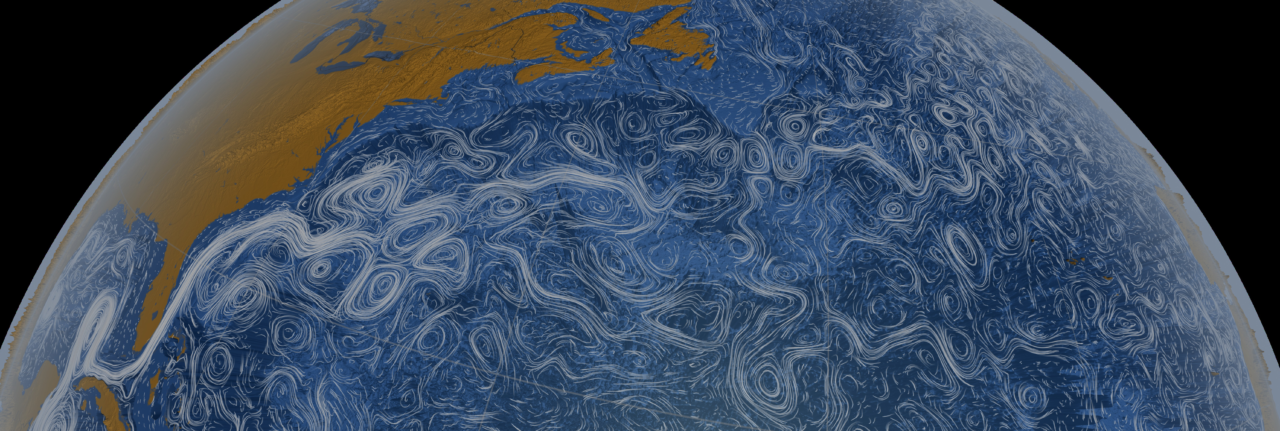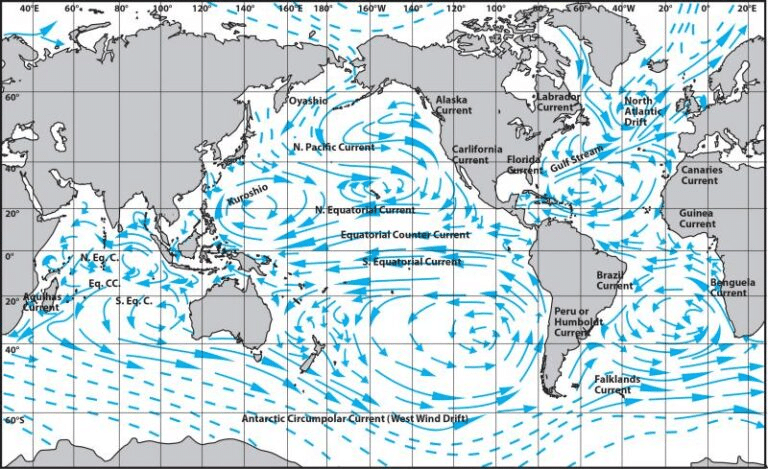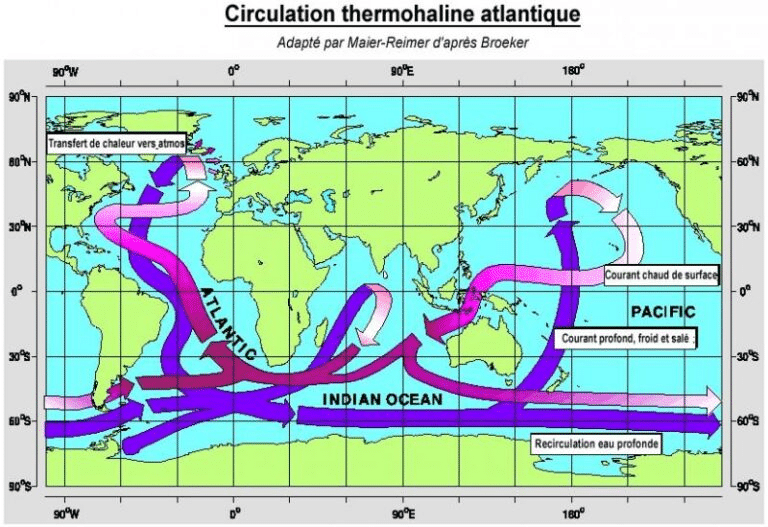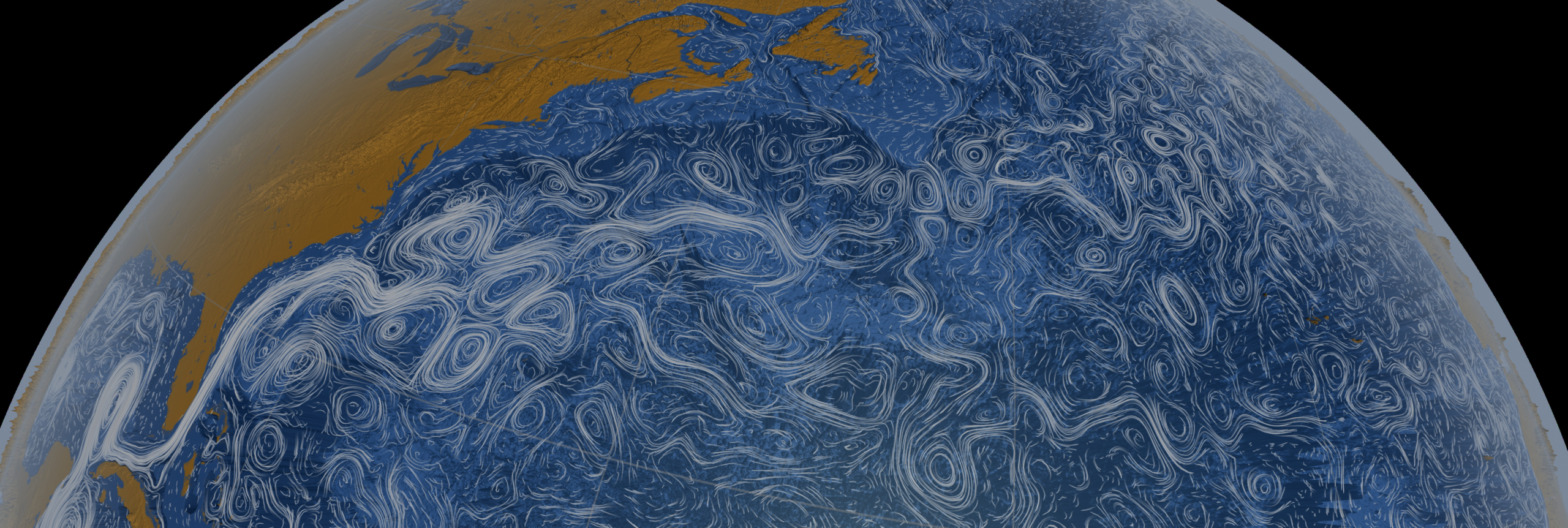
The Gulf Stream has acquired a media reputation ever since the American naval officer Matthew Fontaine Maury, https://en.wikipedia.org/wiki/Matthew_Fontaine_Maury, compared it, in the 19th century, to “central heating” that would benefit the coasts of Western Europe. Brittany, in particular, is said to have an idyllic climate compared to that of Newfoundland, even though it lies at the same latitude. A recurring question is: what would happen if the Gulf Stream stopped?
In the current configuration of planet Earth, the Gulf Stream cannot stop. To understand this, we need only look at the cause of this phenomenon.
The origin of the Gulf Stream
The cause of the Gulf Stream lies in the wind, itself generated by the energy received from the Sun. Maximum in the tropics and very low in the polar regions, solar radiation passes through the Earth’s atmosphere before being absorbed by the oceans (for the most part) and by the tropical continents, which return some of it to the atmosphere. Thus heated at its base, the atmosphere and the oceans it carries with it transfer heat from the equatorial heat source to the cold polar regions.
Because of the Earth’s rotation, this heat transport takes place via atmospheric vortex structures, the first stage of which consists of large subtropical anticyclonic circulations. This great atmospheric circulation mirrors the ocean in a great anticyclonic “noria” that includes the Gulf Stream to the west. This current has its equivalents in other oceans: the Brazil Current in the South Atlantic, the Kuroshio in the North Pacific and the Agulhas Current in the Southern Ocean.

The world’s major ocean surfing currents
For the Gulf Stream to stop, the Azores anticyclone itself would have to vanish, meaning that the equatorial hot spring would no longer be where it is, or the Earth itself would have to stop rotating. Highly improbable hypotheses!
Can the ocean conveyor belt stop?
The meridional overturning circulation, (https://www.aoml.noaa.gov/moc/#:~:text=The%20Meridional%20Overturning%20Circulation%20is,basins%20and%20around%20the%20globe.)
To the north of the Azores High lies the Iceland Low, around which the wind turns counter-clockwise. This low-pressure system is associated with a cyclonic oceanic circulation, made up of the North Atlantic Drift, the Norwegian Current on the eastern edge and the Greenland Current to the south, extended by the Labrador Current to the west. There is no flow discontinuity between the Gulf Stream, driven by the Azores High, and the Norwegian Current, driven by the Iceland Low. It’s as if, in a train, the carriages change locomotive.
The Gulf Stream, the North Atlantic Drift and the Norwegian Current transport warm waters of tropical origin to the Arctic. The situation is similar in the Pacific with the Kuroshio. In both cases, the prevailing westerly winds at temperate latitudes feed off the oceanic heat source, ensuring a temperate climate on the east coasts of both oceans.
In winter, north of the Atlantic, the water cools and increases in salinity due to the formation of pack ice. Denser than the underlying waters, the surface waters plunge into the Norwegian and Greenland Seas to depths of around 3,500 meters. They spread throughout the ocean before gradually rising to the surface and returning to their starting point, like a “conveyor belt”. This kind of suction pump increases the flow of the Gulf Stream and the currents that extend it, and thus the oceanic transport of heat northwards.
This “conveyor belt” of deep waters could diminish or even cease to exist as a result of climate change. In fact, everything points to warmer waters and lower salinity. As sea ice shrinks (
https://climate.copernicus.eu/climate-indicators/sea-ice), the ocean will absorb more heat.
In addition, the melting of Greenland’s glaciers will bring light, fresh water to the surface. Increased precipitation and the flow of rivers flowing into the Arctic will have the same effect. All these phenomena point towards a reduction in the salinity and density of surface waters, and hence in the “heat pump” and northward oceanic transport of heat.
Climate change will not interrupt the Gulf Stream, but it may reduce its intensity. This has already happened in glacial periods, but not in an interglacial period like the one we’re currently experiencing, and it will certainly have climatic consequences in terms of reduced northward oceanic heat transport in the Atlantic.
Despite the similarity of ocean circulation in the Pacific and Atlantic oceans, there are no cold-water plunges in the North Pacific. This is because the closure of this ocean by the Bering Strait limits the progress of currents towards the Arctic and the areas where pack ice forms. What’s more, the waters of the Pacific are much less salty, and therefore lighter, than those of the Atlantic: they don’t sink.

Global ocean circulation
As a result, the north-easterly flow of oceanic heat is higher in the Atlantic than in the Pacific, and the climate is milder in both west and east. At the same latitudes, the climate is milder in Brest than in Vancouver, and on the coasts of Norway than in Alaska, especially in winter.
If the “conveyor belt” were to suddenly stop, Brest’s climate would be close to Vancouver’s. But we’re in a very different situation. However, we are in a period of global warming, and the highest temperature rises are expected in the Arctic. Under these conditions, Europe would not cool down, but would undoubtedly experience less warming.




